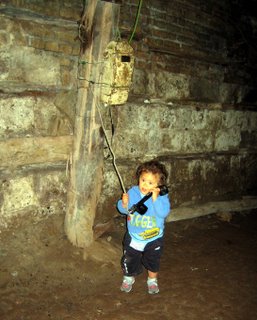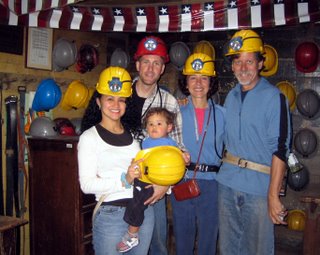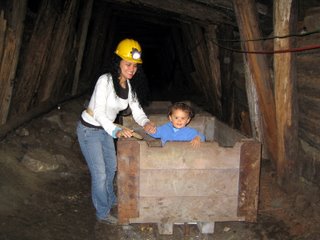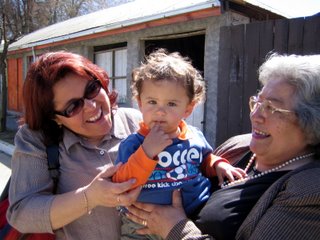 It may seem a little unusual to take a day trip to a coastal town and then spend half the time underground in a coal mine, but that’s what we did. La Costa del Carbon (coast of coal) is a stretch of coastal towns that were built around the coal mining industry that began to thrive in the region in the 1840's. Though the mines officially closed in the late 1990’s, the coal industry had been in decline for several decades leaving the people with little livelihood. The Chilean movie Sub Terra highlights the sad exploitation of the generations of miners in this area whose lives revolved around coal. (If you haven’t seen the movie, we highly recommend it).
It may seem a little unusual to take a day trip to a coastal town and then spend half the time underground in a coal mine, but that’s what we did. La Costa del Carbon (coast of coal) is a stretch of coastal towns that were built around the coal mining industry that began to thrive in the region in the 1840's. Though the mines officially closed in the late 1990’s, the coal industry had been in decline for several decades leaving the people with little livelihood. The Chilean movie Sub Terra highlights the sad exploitation of the generations of miners in this area whose lives revolved around coal. (If you haven’t seen the movie, we highly recommend it).  Lota, the town we visited, has turned one of the most notorious mines, El Chiflón del Diablo (Wind of the Devil), into a historic attraction with some of the unemployed miners as the guides to their former world below. We made our way to Lota, located an hour and half drive south from San Pedro de la Paz, with our friends Dan & Catherine (another Fulbright teacher from Portland & her husband).
Lota, the town we visited, has turned one of the most notorious mines, El Chiflón del Diablo (Wind of the Devil), into a historic attraction with some of the unemployed miners as the guides to their former world below. We made our way to Lota, located an hour and half drive south from San Pedro de la Paz, with our friends Dan & Catherine (another Fulbright teacher from Portland & her husband).  We were a bit skeptical of taking the mine tour, but the miners’ sincerity and spirit convinced us it would be an interesting experience. They didn’t disappoint us. With Nathan at our side, the 5 of us along with our guide descended down the mine shaft 130 ft in the elevator bucket to the labyrinth below. Telling his stories of the conditions, his experiences and the often tragic history of this infamous mine, he lead us through the old mine tunnel that burrowed under the sea.
We were a bit skeptical of taking the mine tour, but the miners’ sincerity and spirit convinced us it would be an interesting experience. They didn’t disappoint us. With Nathan at our side, the 5 of us along with our guide descended down the mine shaft 130 ft in the elevator bucket to the labyrinth below. Telling his stories of the conditions, his experiences and the often tragic history of this infamous mine, he lead us through the old mine tunnel that burrowed under the sea.  It was strange to think that we were walking in a hole under the roaring ocean or more importantly that people worked in these primitive conditions with few safety measures. Mining anywhere in the world is a dangerous occupation, but these men (and boys as young as 9 years old) sacrificed a lot for very little.
It was strange to think that we were walking in a hole under the roaring ocean or more importantly that people worked in these primitive conditions with few safety measures. Mining anywhere in the world is a dangerous occupation, but these men (and boys as young as 9 years old) sacrificed a lot for very little.
We finished our day in Lota wandering through the Parque Botánico de Doña Isidora Goyenechea, a beautiful natural park perched on top of a small peninsula overlooking the coast. The park is well maintained and stocked with native plants and trees from Chile and surrounding South American countries. The views of the fishing bay and rugged coastline were spectacular. Listening to the neotropic cormorants (Phalacrocorax brasilianus) socializing in the large trees perched over the cliff, we watched the sun disappear over the Pacific and pondered how fortunate we are. 
 Combined with its neighboring cities, Concepción stacks up as the second largest city in Chile with a population of around a million. The big city acts as an important industrial port hub being located in practically the middle of the country and hosts several universities which lend a young energetic feel to the city vibe. Founded in 1550, Concepción has endured an interesting history including acting as the northern border for the Mapuche resistance (indigenous peoples), a political stronghold for the Marxist movement in the late sixties and suffered several large earthquakes that have literally moved the city’s location.
Combined with its neighboring cities, Concepción stacks up as the second largest city in Chile with a population of around a million. The big city acts as an important industrial port hub being located in practically the middle of the country and hosts several universities which lend a young energetic feel to the city vibe. Founded in 1550, Concepción has endured an interesting history including acting as the northern border for the Mapuche resistance (indigenous peoples), a political stronghold for the Marxist movement in the late sixties and suffered several large earthquakes that have literally moved the city’s location.
Situated on the south side of the mighty Bio Bio River and across the river from Concepción, San Pedro de la Paz is the small city we call home. Liceo San Pedro, Sara Marisol’s Fulbright exchange high school is located near the center of the villa and drew us to this area. Upon arrival to Chile, Sara and Nathan found a small house to rent from Marcela, a friend of Loreto Bustos (the exchange teacher). Marcela and her mother, “Abuela”  (or “grandmother” as she likes to be called), welcomed us with open arms and helped Sara and Nathan settled into the neighborhood. Marcela and Abuela who live just around the corner have really treated as well and like to visit with Nathan. Our house is just a 5 minute walk from the Liceo and came furnished or “over furnished” (with everything someone collects through out a life time and not always need): Doug spent the first couple of weeks reorganizing the space to make it “Nathan proof”. All and all it’s a cozy place with everything we need. In fact, it has been quite nice to do away with an energy-sucking dryer and have fresh smelling clothes dried the old fashioned way.
(or “grandmother” as she likes to be called), welcomed us with open arms and helped Sara and Nathan settled into the neighborhood. Marcela and Abuela who live just around the corner have really treated as well and like to visit with Nathan. Our house is just a 5 minute walk from the Liceo and came furnished or “over furnished” (with everything someone collects through out a life time and not always need): Doug spent the first couple of weeks reorganizing the space to make it “Nathan proof”. All and all it’s a cozy place with everything we need. In fact, it has been quite nice to do away with an energy-sucking dryer and have fresh smelling clothes dried the old fashioned way.
As the photo of our house (the yellow half) shows, many of the residences in Chile are built as duplexes to keep construction costs down. The street we live on is called a Pasaje (a side street with little traffic) which is ideal for us. It’s a middle class neighborhood, but doesn’t compare in terms of openness to our Portland neighborhood. The neighbors are friendly to us, but don’t seem to relate or really know each other, which seems odd. This is apparently not uncommon. In general though, we have been treated quite well by Chileans thus far. Our other neighbors though are downright rude at times getting into fights, making noise at all hours of the night and leaving unwanted “presents” everywhere around the house. To clarify, I am talking about the stray cats that drive us crazy at times, particularly at night when they pounce around on the roof making me think I am actually living in the house of spirits. We actually like the neighborhood dogs that are mostly friendly and non-threatening, though leaving Sobaka in the states was a wise decision. Unfortunately, like many other countries, Chile has a problem with their stray cat and dog populations and albeit slowly, they are trying to make needed changes to help & protect the animals.
We have a small fenced-in backyard that Doug has taken on as his gardening project. Little did he know the elements he would face in this endeavor including the relentless cats, unknown funguses, plagues of snails, non-draining soil and some of the most intense UV rays in the world. The verdict on the fruits of his labor won’t be known until after Christmas, but the cilantro appears to be thriving.
 There is a small family corner shop just 3 houses down the street and a basic bakery with warm, fresh bread around the corner. Monday through Saturday, Daniel the “verduras” man makes his way through the neighborhood around noontime selling fresh fruit and vegetables from the nearby farms out of back his horse-driven cart. This is truly what buying local is all about.
There is a small family corner shop just 3 houses down the street and a basic bakery with warm, fresh bread around the corner. Monday through Saturday, Daniel the “verduras” man makes his way through the neighborhood around noontime selling fresh fruit and vegetables from the nearby farms out of back his horse-driven cart. This is truly what buying local is all about.  The community as a whole has much to offer. Along with being a quiet, clean and safe place to live, the area has many little “green-strip” parks along the streets that are well maintained with colorful annuals and playgrounds. There are two lakes in San Pedro de la Paz: the larger one just a 10 minute walk away. The big lake has a very active outdoor amphitheater, an open park with lots to do and a bike trail around its perimeter. The lake also is a great place to fly a kite (a favorite Chilean pastime), go boating or check out the birdlife including the unique Chilean black necked swans (Cygnus melancoryphus)
The community as a whole has much to offer. Along with being a quiet, clean and safe place to live, the area has many little “green-strip” parks along the streets that are well maintained with colorful annuals and playgrounds. There are two lakes in San Pedro de la Paz: the larger one just a 10 minute walk away. The big lake has a very active outdoor amphitheater, an open park with lots to do and a bike trail around its perimeter. The lake also is a great place to fly a kite (a favorite Chilean pastime), go boating or check out the birdlife including the unique Chilean black necked swans (Cygnus melancoryphus)  who frequent the shallows in the spring and summer months. Public transportation is quite good from where we live. We have multiple bus lines that pass by the end of our street that will take you anywhere in the Concepcion area and a new light rail stop just a few blocks away. So, that our new neighborhood: come by for a visit, you’re all invited.
who frequent the shallows in the spring and summer months. Public transportation is quite good from where we live. We have multiple bus lines that pass by the end of our street that will take you anywhere in the Concepcion area and a new light rail stop just a few blocks away. So, that our new neighborhood: come by for a visit, you’re all invited.
 It may seem a little unusual to take a day trip to a coastal town and then spend half the time underground in a coal mine, but that’s what we did. La Costa del Carbon (coast of coal) is a stretch of coastal towns that were built around the coal mining industry that began to thrive in the region in the 1840's. Though the mines officially closed in the late 1990’s, the coal industry had been in decline for several decades leaving the people with little livelihood. The Chilean movie Sub Terra highlights the sad exploitation of the generations of miners in this area whose lives revolved around coal. (If you haven’t seen the movie, we highly recommend it).
It may seem a little unusual to take a day trip to a coastal town and then spend half the time underground in a coal mine, but that’s what we did. La Costa del Carbon (coast of coal) is a stretch of coastal towns that were built around the coal mining industry that began to thrive in the region in the 1840's. Though the mines officially closed in the late 1990’s, the coal industry had been in decline for several decades leaving the people with little livelihood. The Chilean movie Sub Terra highlights the sad exploitation of the generations of miners in this area whose lives revolved around coal. (If you haven’t seen the movie, we highly recommend it).  Lota, the town we visited, has turned one of the most notorious mines, El Chiflón del Diablo (Wind of the Devil), into a historic attraction with some of the unemployed miners as the guides to their former world below. We made our way to Lota, located an hour and half drive south from San Pedro de la Paz, with our friends Dan & Catherine (another Fulbright teacher from Portland & her husband).
Lota, the town we visited, has turned one of the most notorious mines, El Chiflón del Diablo (Wind of the Devil), into a historic attraction with some of the unemployed miners as the guides to their former world below. We made our way to Lota, located an hour and half drive south from San Pedro de la Paz, with our friends Dan & Catherine (another Fulbright teacher from Portland & her husband).  We were a bit skeptical of taking the mine tour, but the miners’ sincerity and spirit convinced us it would be an interesting experience. They didn’t disappoint us. With Nathan at our side, the 5 of us along with our guide descended down the mine shaft 130 ft in the elevator bucket to the labyrinth below. Telling his stories of the conditions, his experiences and the often tragic history of this infamous mine, he lead us through the old mine tunnel that burrowed under the sea.
We were a bit skeptical of taking the mine tour, but the miners’ sincerity and spirit convinced us it would be an interesting experience. They didn’t disappoint us. With Nathan at our side, the 5 of us along with our guide descended down the mine shaft 130 ft in the elevator bucket to the labyrinth below. Telling his stories of the conditions, his experiences and the often tragic history of this infamous mine, he lead us through the old mine tunnel that burrowed under the sea.  It was strange to think that we were
It was strange to think that we were 
 Combined with its neighboring cities, Concepción stacks up as the second largest city in Chile with a population of around a million. The big city acts as an important industrial port hub being located in practically the middle of the country and hosts several universities which lend a young energetic feel to the city vibe. Founded in 1550, Concepción has endured an interesting history including acting as the northern border for the Mapuche resistance (indigenous peoples), a political stronghold for the Marxist movement in the late sixties and suffered several large earthquakes that have literally moved the city’s location.
Combined with its neighboring cities, Concepción stacks up as the second largest city in Chile with a population of around a million. The big city acts as an important industrial port hub being located in practically the middle of the country and hosts several universities which lend a young energetic feel to the city vibe. Founded in 1550, Concepción has endured an interesting history including acting as the northern border for the Mapuche resistance (indigenous peoples), a political stronghold for the Marxist movement in the late sixties and suffered several large earthquakes that have literally moved the city’s location.


 The community as a whole has much to offer. Along with being a quiet, clean and safe place to live, the area has many little “green-strip” parks along the streets that are well maintained with colorful annuals and playgrounds. There are two lakes in San Pedro de la Paz: the larger one just a 10 minute walk away. The big lake has a very active outdoor amphitheater, an open park with lots to do and a bike trail around its perimeter. The lake also is a great place to fly a kite (a favorite Chilean pastime),
The community as a whole has much to offer. Along with being a quiet, clean and safe place to live, the area has many little “green-strip” parks along the streets that are well maintained with colorful annuals and playgrounds. There are two lakes in San Pedro de la Paz: the larger one just a 10 minute walk away. The big lake has a very active outdoor amphitheater, an open park with lots to do and a bike trail around its perimeter. The lake also is a great place to fly a kite (a favorite Chilean pastime), 
